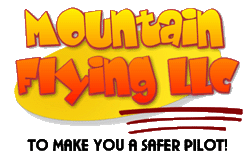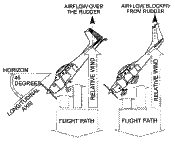About Stalls
Stalls — A Frightening Experience?
Full-power stalls need not be scary
Fear of the unknown
Stalls used to bother me. Back in my student pilot days, solo practice of stalls caused a lot of consternation. The darn airplane seemed to do something different each time it stalled. One day the wing would fall off to the left side, the next day to the right side and occasionally the wings would fall through the horizon in a level attitude.
Stalls were scary. We all fear the unknown. You do, and I do. We definitely are afraid of something about which we know nothing. For example, if a snake slithers across the floor, many people will climb onto a table and start hollering for help. The little snake might be harmless, but not knowing about snakes, we still fear it.
Stalls can instill the same dread until we determine what is happening aerodynamically. The following explanation of why the airplane reacts as it does during a stall can help relieve apprehension and build self-confidence at the same time.
Aerodynamics
An understanding of basic aerodynamics is necessary to understand why an airplane’s wings may rotate to one side or the other during a stall. Stalls then become predictable. When you can predict what the airplane is going to do and why it is doing it, stalls are no longer scary. They may still arouse some apprehension, but not fear.
To begin with, the airplane creates a relative wind when it flies. This wind is relative to the flight path. Theoretically, if the airplane is being flown in coordinated flight, when it stalls the wings would move down through the horizon in a level attitude. This is not the case and this is the reason for apprehension.
During a slip, the horizontal lift component (centripetal force) of the turn exceeds the centrifugal force. The flight path of the airplane is toward the inside of the turn. The airplane flies toward the ball of the turn coordinator. During a skid, the centrifugal force exceeds the centripetal force and the flight path is toward the outside of the turn. The airplane flies toward the ball.
Stalls
Assume the airplane is climbing with full power and the wings level. It is proper to step on the right rudder to compensate for torque, p-factor, gyroscopic precession of the propeller and the corkscrewing effect of the propeller slipstream (See Left-turning Forces at bottom). If right rudder is not applied, the turn coordinator would show the wings level and the ball off to the right side. The airplane flies toward the ball and in doing so creates a relative wind angling from the right. The fuselage blocks a portion of the relative wind to the left wing. When the airplane stalls (I hesitate to say the wing falls off), but the left wing with less lift will stall first and the airplane will rotate to the left away from the ball.
Assume the same condition but with the application of too much right rudder. Now the turn coordinator displays the wings level and the ball is to the left side. Again the airplane flies toward the ball. The relative wind strikes the airplane from an angle on the left side. This blocks a portion of the airflow to the right wing. When the airplane stalls, the right wing stalls first (the wing falls opposite the ball).
Don’t quit reading yet. Thinking we have stalls figured out, we might stall the airplane with the power on, wings level and the ball centered. We might expect the airplane to fall through the horizon with the wings level. The fear of stalls may return when the airplane falls to the right side. What happened? One of the left-turning forces we compensate for during climbs is the corkscrewing effect of the propeller slipstream. When viewed from behind the airplane, this invisible force is creating a clockwise swirling mass of air that strikes the left side of the airplane and the vertical stabilizer. At the moment of the stall, the slipstream lifts away from the vertical stabilizer. This results in too much right rudder for the new condition of flight and the airplane falls to the right.
It is not advocated that the airplane be flown in uncoordinated flight; however, for practicing power-on stalls, adjust the rudder pressure so the ball of the turn coordinator is about one-half width to the right of the index. The wings will fall through the horizon in a level attitude.
When practicing power-off stalls, normal coordination is used.
Stalls no longer represent the unknown. Go out and enjoy them.
Left-turning Forces
In most American-built airplanes, climbing with the power on requires right rudder application to compensate for the four turning forces.
1. Torque
Newton's third law of physics (every action has an equal and opposite reaction) explains the torque effect. The propeller spins in a clockwise direction when viewed from the cockpit. The equal and opposite reaction rotates the airplane in a counterclockwise direction.
2. P-factor (asymmetric loading of the propeller)
P-factor results in a left-turning tendency of the airplane due to the right side of the propeller producing greater thrust than the left side. During climbs, the flight path of the airplane does not parallel the angle formed by the longitudinal axis (there is insufficient thrust available). The prop blades are perpendicular to the longitudinal axis and point above the actual flight path. This results in the left ascending blade having a smaller angle of attack than the right descending prop blade.
3. Gyroscopic precession
Any spinning object with mass will exhibit the properties of a gyroscope. One of the properties is called precession. A gyro tends to resist an applied force, but will react in relation to that force, but 90 degrees in the plane of rotation.
Climbing applies a force to the prop cambered side (front side) at the bottom of its arc and the face (flat side or back) at the top of its arc. The force, 90 degrees in the plane of rotation, causes a left-turning tendency.
4. Corkscrewing effect
The corkscrewing effect of the propeller slipstream occurs as the propeller rotates in a clockwise direction to direct a stream of air rearward. This aft-moving slipstream rotates in a corkscrewing manner (clockwise when viewed from the cockpit).
At high speeds the corkscrewing effect is elongated. During takeoff or slow flight it becomes more compact. It's effect is concentrated on the left side of the airplane.
Aircraft manufacturers switched from the straight-tail design to the swept-tail design during the early 1960s. While this makes the airplanes look sleek, it changes the manner of spin recovery.
During a spin in a straight-tail airplane, rudder is applied to stop the rotation. With the swept-tail airplane, the control wheel (stick) must be moved forward to induce airflow over the vertical stabilizer and rudder before the rotation can be
stopped.
![]()
![]()


